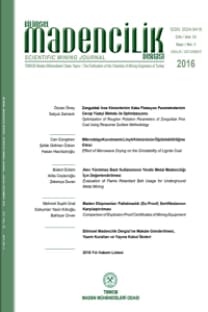Investigation of factors affecting hearing loss of open pit coal mine employees with categorical data analyses
Hiyerarşik log-lineer analiz, Lojistik regresyon, Madencilik, Gürültüye bağlı işitme kaybı, Meslek hastalığı
Investigation of factors affecting hearing loss of open pit coal mine employees with categorical data analyses
Hierarchical log-linear analysis, Logistic regression, Mining, Noise induced hearing loss, Occupational disease,
___
- Agresti, A. 2002. Categorical Data Analysis. New Jersey: John Wiley and Sons. Inc.
- Bauer, E.R., Babich, D.R., Vipperman, J.R. 2006. Equipment noise and worker exposure in the coal mining industry (No. 9492). Department of Health and Human Services, Public Health Service, Centers for Disease Control and Prevention, National Institute for Occupational Safety and Health, Pittsburgh Research Laboratory.
- Concha-Barrientos, M., Campbell-Lendrum, D., Steenland, K. 2004. Occupational noise: assessing the burden of disease from work-related hearing impairment at national and local levels. WHO Environmental Burden of Disease Series, No:9, Geneva
- Goelzer, B.I.F. 2001. Hazard prevention and control programmes. Goelzer, B., Hansen, C.H., Sehrndt, G.A. (Ed.). Occupational Exposure to Noise: Evaluation, Prevention and Control, WHO, Geneva, 233-244.
- Hong, O., Kerr, M.J., Poling, G.L., Dhar, S. 2013. Understanding and preventing noise-induced hearing loss. Disease-a-Month 59(4):110-118. doi: 10.1016/j.disamonth.2013.01.002
- ISO 1999. 2013. Acoustics—estimation of noise-induced hearing loss, in international standard. ISO, Switzerland
- Iwasaki, Y., Fukaya, K., Fuchida, S., Matsumoto, S., Araoka, D., Tokoro, C., Yasutaka, T. 2021. Projecting future changes in element concentrations of approximately 100 untreated discharges from legacy mines in Japan by a hierarchical log-linear model. Science of the Total Environment, 786, doi:10.1016/j.scitotenv.2021.147500
- Kovalchik, P.G., Matetic, R.J., Smith, A.K., Bealko, S.B. 2008. Application of prevention through design for hearing loss in the mining industry. Journal of Safety Research, 39(2), 251-254. doi:10.1016/j.jsr.2008.02.029
- Kursunoglu, N., Gogebakan M. 2021. Prediction of spontaneous coal combustion tendency using multinomial logistic regression, International Journal of Occupational Safety and Ergonomics, doi: 10.1080/10803548.2021.1944535
- Maiti, J., Bhattacherjee, A., Bangdiwala, S.I. 2001. Loglinear model for analysis of cross-tabulated coal mine injury data. Injury control and safety promotion, 8(4), 229-236. doi:10.1076/icsp.8.4.229.3335
- Nelson, D.I., Nelson, R.Y., Concha‐Barrientos, M., Fingerhut, M. 2005. The global burden of occupational noise‐induced hearing loss. American Journal of Industrial Medicine, 48(6), 446-458. doi:10.1002/ajim.20223
- Official Gazette. 2013. Regulation on protection of employees from noise related risks. No. 28721. https://www.resmigazete.gov.tr/eskiler/ 2013/07/20130728-11.htm. [Accessed 02 August 2013].
- Onder, M., Demir Iroz, B., Onder, S. 2021. Using categorical data analyses in determination of dust-related occupational diseases in mining, International Journal of Occupational Safety and Ergonomics. 27(1),112- 120. doi:10.1080/10803548.2018.1531535
- Onder, S. 2013. Evaluation of occupational injuries with lost days among opencast coal mine workers through logistic regression models. Safety Science. 59, 86-92. doi:10.1016/j.ssci.2013.05.002
- Onder, S., Mutlu, M. 2017. Analyses of non-fatal accidents in an opencast mine by logistic regression model - a case study. International Journal of Injury Control and Safety Promotion. 24(3), 328-337. doi:10.1080/ 17457300.2016.1178299
- Phillips, J.I., Heyns, P.S., Nelson, G. 2007. Rock drills used in South African mines: a comparative study of noise and vibration levels. The Annals of occupational hygiene, 51(3), 305-310. doi:10.1093/annhyg/mel082
- Picard, M., Girard, S.A., Simard, M., Larocque, R., Leroux, T., Turcotte, F. 2008. Association of work-related accidents with noise exposure in the workplace and noise-induced hearing loss based on the experience of some 240,000 person-years of observation. Accident Analysis & Prevention, 40(5), 1644-1652. doi:10.1016/j.aap.2008.05.013
- Sensogut, C., Cinar, I. 2007. An empirical model for the noise propagation in open cast mines–A case study. Applied Acoustics, 68(9), 1026-1035. doi:10.1016/j.apacoust.2006.04.016
- Sharma, O., Mohanan, V., Singh, M. 1998. Noise emission levels in coal industry. Applied Acoustics, 54(1), 1-7. doi:10.1016/S0003- 682X(97)00073-X
- TS 2607 ISO 1999. 2005. Acoustics - Determination of occupational noise exposure and estimation of noise-induced hearing impairment. ISO, Ankara (in Turkish).
- Vipperman, J. S., Bauer, E.R., Babich, D.R. 2007. Survey of noise in coal preparation plants. The Journal of the Acoustical Society of America,
- ISSN: 2564-7024
- Yayın Aralığı: 4
- Yayıncı: TMMOB Maden Mühendisleri Odası
Modifiye kalsitin dolgu tutunumu ve fluting kağıtların mekanik özellikleri üzerine etkileri
Eleme ve sınıflandırma ürünlerinin sözde rastgele sayı üretme rutiniyle tahmini
Quantifying the effect of the grinding aids in a batch stirred mill by a modelling approach
Tamer SÖZBİR, Mustafa ÇİÇEKLER
Yicong ZENG, Hailiang XU, Bo WU
Kalsitik ve dolomitik kireçtaşlarının çimentolu macun dolgunun çevresel davranışına etkisi
Predicting screening/classification products via the pseudorandom number selection routine
